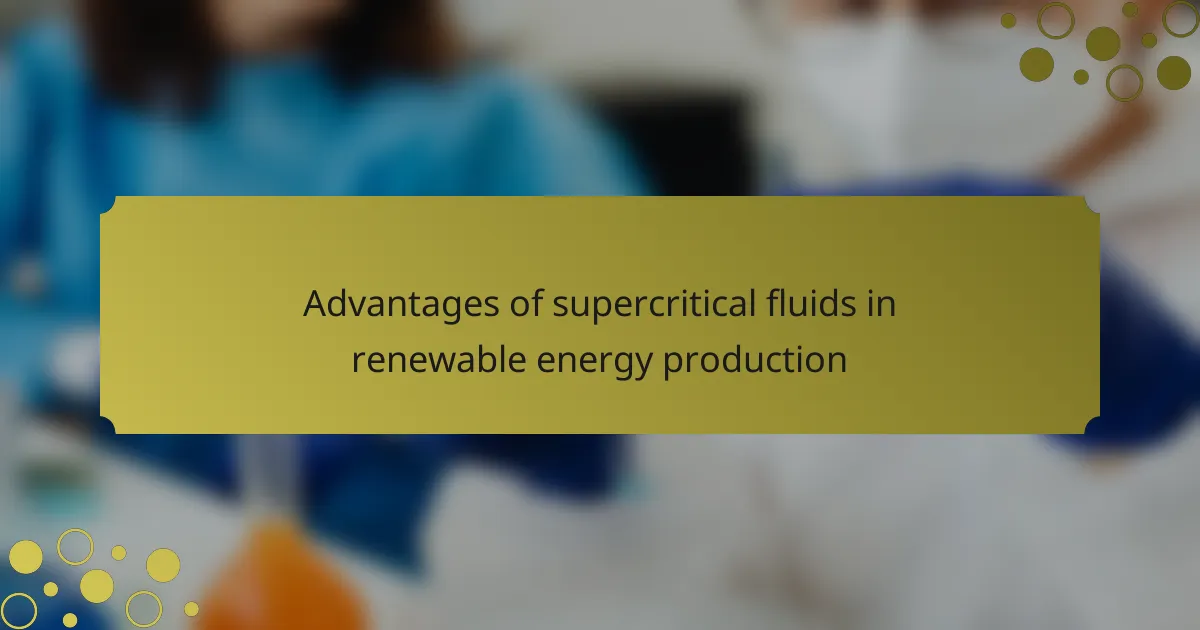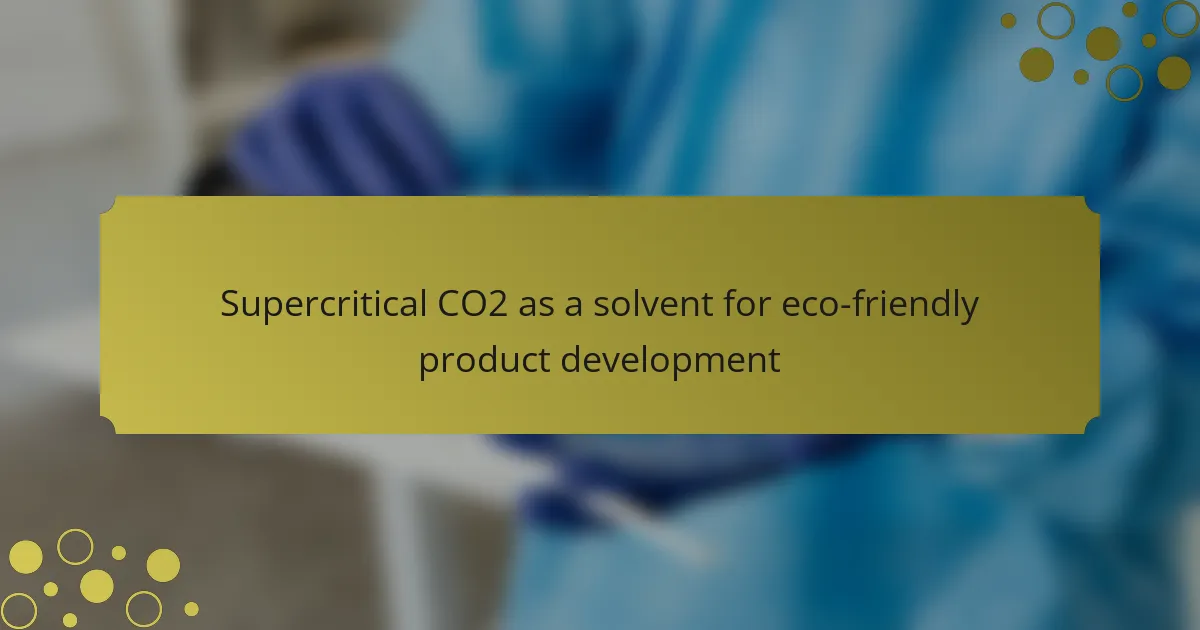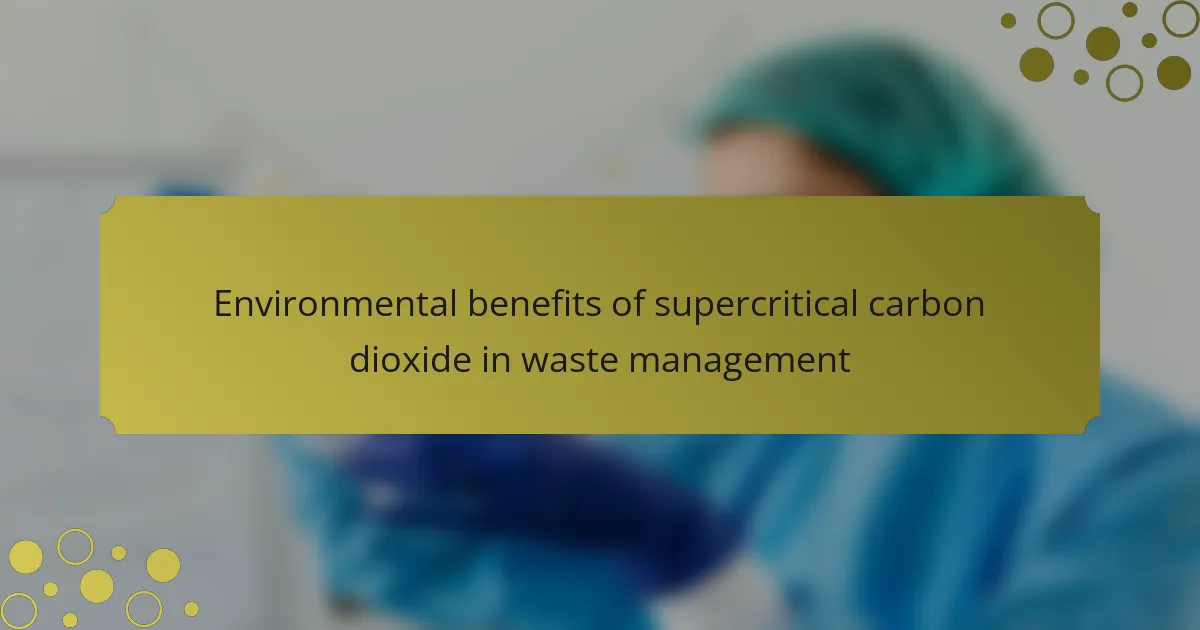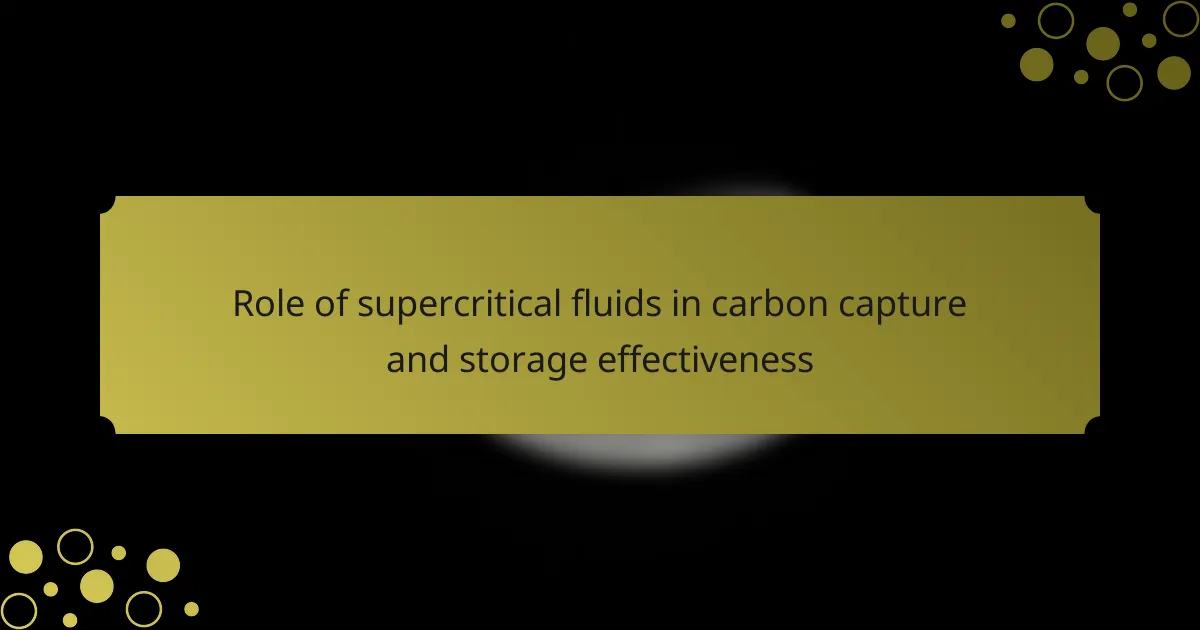Supercritical fluid technology involves the use of fluids, such as supercritical carbon dioxide, above their critical temperature and pressure, enabling unique properties that enhance solubility and diffusivity. This technology is significant for its applications in extraction processes, such as decaffeination of coffee and essential oil extraction, while also contributing to reduced industrial emissions and hazardous waste generation. Although supercritical fluid technology presents challenges, including high operational pressures and equipment complexity, it offers substantial benefits in energy efficiency and environmental sustainability. Research indicates that this method can achieve significant reductions in greenhouse gas emissions, supporting cleaner production methods across various industries.
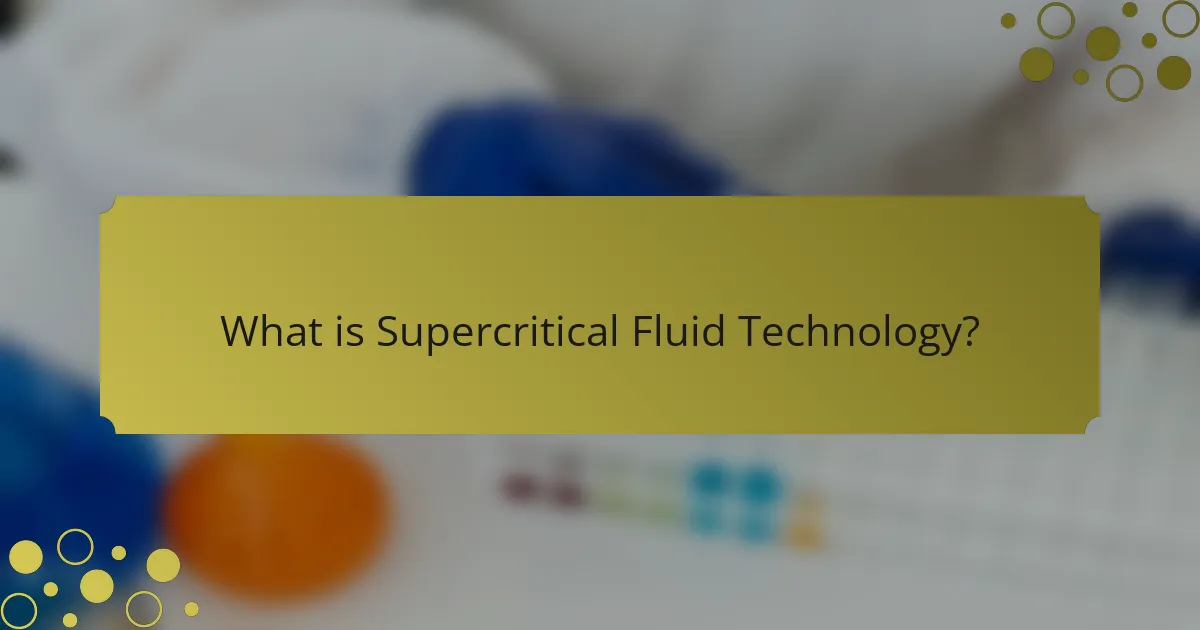
What is supercritical fluid technology?
Supercritical fluid technology utilizes fluids above their critical temperature and pressure. In this state, fluids exhibit unique properties that are neither purely liquid nor gas. This allows for enhanced solubility and diffusivity. Supercritical carbon dioxide is commonly used due to its low toxicity and environmental impact. The technology is applied in extraction processes, such as decaffeination of coffee and extraction of essential oils. It also plays a role in reducing industrial emissions by enabling cleaner production methods. Research shows that supercritical fluid processes can minimize hazardous waste generation. This technology supports sustainable practices in various industries.
How does supercritical fluid technology function?
Supercritical fluid technology functions by utilizing fluids at temperatures and pressures above their critical points. At this state, the fluid exhibits unique properties of both gases and liquids. Supercritical fluids can dissolve materials like a liquid while having the ability to diffuse through solids like a gas. This allows for efficient extraction of compounds without traditional solvents. The technology is often applied in processes like extraction, chromatography, and material processing. For example, carbon dioxide is commonly used as a supercritical fluid due to its low toxicity and cost-effectiveness. Studies show that supercritical CO2 extraction can reduce solvent waste significantly, thus minimizing industrial emissions.
What are the key properties of supercritical fluids?
Supercritical fluids possess unique properties that distinguish them from gases and liquids. They exhibit high density, which allows them to dissolve substances like liquids. Supercritical fluids also have low viscosity, enhancing mass transfer rates. Their diffusivity is higher than that of liquids, facilitating rapid transport of solutes. Additionally, they can be fine-tuned by adjusting temperature and pressure, offering versatility in applications. These characteristics make supercritical fluids effective solvents in extraction processes. For instance, supercritical carbon dioxide is widely used in decaffeination and essential oil extraction.
How is supercritical fluid technology applied in industrial settings?
Supercritical fluid technology is applied in industrial settings for extraction, cleaning, and chemical reactions. This technology utilizes supercritical fluids, typically carbon dioxide, to dissolve materials efficiently. In extraction, it replaces traditional solvents, reducing harmful emissions. For cleaning, supercritical fluids effectively remove contaminants from equipment and surfaces. In chemical reactions, they enhance reaction rates and selectivity. Studies show that using supercritical CO2 can decrease volatile organic compound emissions significantly. This technology is increasingly adopted in industries like pharmaceuticals, food processing, and materials science.
Why is minimizing industrial emissions important?
Minimizing industrial emissions is crucial for environmental protection and public health. High levels of emissions contribute to air pollution, which can lead to respiratory diseases and other health issues. According to the World Health Organization, air pollution causes approximately 7 million premature deaths annually. Additionally, industrial emissions significantly contribute to climate change by increasing greenhouse gas concentrations in the atmosphere. The Intergovernmental Panel on Climate Change states that limiting emissions is essential to keeping global temperature rise below 1.5 degrees Celsius. Reducing these emissions also helps in meeting regulatory standards and promoting sustainable industrial practices. Ultimately, minimizing emissions supports a healthier ecosystem and a safer environment for future generations.
What are the environmental impacts of industrial emissions?
Industrial emissions significantly contribute to environmental degradation. They release pollutants such as carbon dioxide, sulfur dioxide, and nitrogen oxides. These emissions lead to air pollution, which affects human health and ecosystems. Industrial emissions also contribute to climate change by increasing greenhouse gas concentrations. Water bodies can be contaminated through runoff from industrial sites. Soil quality deteriorates due to the deposition of heavy metals and other toxic substances. Biodiversity loss occurs as habitats are altered or destroyed by industrial activities. According to the Environmental Protection Agency, industrial sources account for about 20% of total U.S. greenhouse gas emissions.
How do regulations influence the need for emission reduction?
Regulations create legal requirements that compel industries to reduce emissions. These rules often set specific limits on the amount of pollutants that can be released. For example, the Clean Air Act in the United States mandates reductions in harmful emissions from industrial sources. Compliance with these regulations often necessitates the adoption of cleaner technologies. Supercritical fluid technology is one such method that can help meet these regulatory standards. Additionally, regulations can impose financial penalties for non-compliance. This economic incentive further drives industries to seek emission reduction solutions. Overall, regulations play a crucial role in shaping the need for emissions reductions across various sectors.
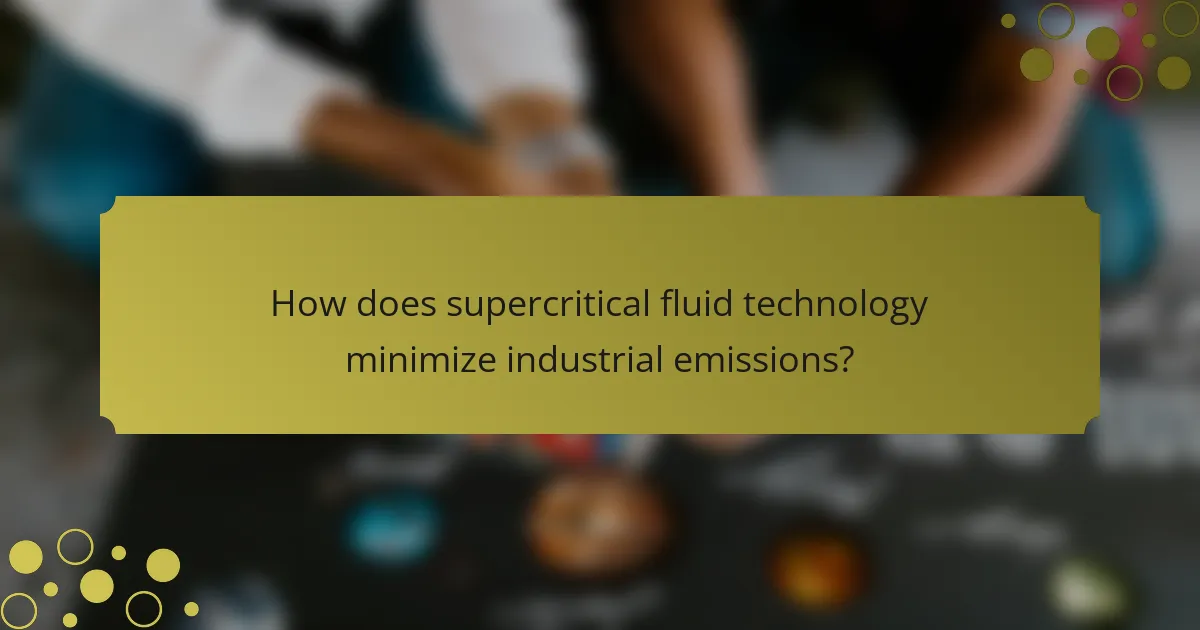
How does supercritical fluid technology minimize industrial emissions?
Supercritical fluid technology minimizes industrial emissions by using supercritical fluids as solvents for extraction and processing. This method reduces the need for harmful organic solvents, which often release volatile organic compounds (VOCs) into the atmosphere. Supercritical fluids, such as carbon dioxide, have low toxicity and can be recycled easily. Their use leads to lower emissions of greenhouse gases compared to traditional methods. Studies show that processes utilizing supercritical fluids can achieve up to 90% reduction in emissions. This technology also improves energy efficiency, further contributing to lower overall emissions in industrial applications.
What processes utilize supercritical fluids for emission reduction?
Supercritical fluid processes used for emission reduction include supercritical fluid extraction, supercritical carbon dioxide cleaning, and supercritical fluid combustion. Supercritical fluid extraction utilizes carbon dioxide to extract valuable compounds from biomass while minimizing solvent emissions. This method reduces the need for volatile organic compounds, which are harmful pollutants. Supercritical carbon dioxide cleaning employs supercritical CO2 as a solvent to remove contaminants from surfaces, reducing hazardous waste generation. Supercritical fluid combustion enhances fuel efficiency and reduces emissions by promoting complete combustion at lower temperatures. These processes demonstrate the effectiveness of supercritical fluids in minimizing industrial emissions.
How does supercritical fluid extraction work?
Supercritical fluid extraction (SFE) works by utilizing supercritical fluids to extract compounds from solid or liquid matrices. A supercritical fluid is a substance at a temperature and pressure above its critical point, exhibiting properties of both a gas and a liquid. In SFE, carbon dioxide is commonly used due to its low toxicity and ability to selectively extract various compounds.
The process begins by placing the material to be extracted in a vessel. The supercritical fluid is then introduced under high pressure and temperature. This fluid penetrates the material, dissolving the desired compounds effectively. The extraction occurs as the supercritical fluid interacts with the target molecules, breaking down cell walls and allowing for efficient extraction.
Once the extraction is complete, the pressure is reduced to separate the extracted compounds from the supercritical fluid. This results in the precipitation of the target compounds, which can then be collected. The process is efficient, environmentally friendly, and often results in higher purity extracts compared to traditional methods.
SFE is widely used in the food, pharmaceutical, and cosmetic industries for extracting flavors, essential oils, and active ingredients. Its efficiency and selectivity make it a valuable technology for minimizing industrial emissions while maximizing product quality.
What role do supercritical fluids play in carbon capture?
Supercritical fluids play a crucial role in carbon capture by enhancing the efficiency of CO2 separation and storage. These fluids exist at conditions above their critical temperature and pressure, allowing them to exhibit unique properties. Supercritical CO2 has a high density and low viscosity, which improves its ability to dissolve and transport gases. This characteristic enables supercritical fluids to selectively capture CO2 from industrial emissions more effectively than traditional methods. Studies show that using supercritical CO2 in carbon capture processes can increase capture rates significantly, making it a viable option for reducing greenhouse gas emissions.
What are the benefits of using supercritical fluid technology?
Supercritical fluid technology offers several benefits for industrial applications. It enhances extraction efficiency by using supercritical fluids to dissolve substances more effectively than traditional solvents. This method reduces the need for harmful organic solvents, minimizing environmental impact. Supercritical fluids can also be tuned to selectively extract desired compounds, improving product purity. The technology operates at lower temperatures, preserving sensitive compounds and reducing energy consumption. Additionally, it generates less waste compared to conventional methods, aligning with sustainability goals in industrial processes. These attributes contribute to a cleaner and more efficient production environment.
How does this technology improve efficiency in industrial processes?
Supercritical fluid technology improves efficiency in industrial processes by enhancing extraction and separation methods. It utilizes supercritical fluids, which have unique properties that allow for better solvation and mass transfer. This results in reduced energy consumption compared to traditional methods. For instance, supercritical CO2 can extract compounds at lower temperatures, preserving product integrity. Studies indicate that this technology can increase yield by up to 30%. Additionally, it minimizes the use of solvents, leading to lower waste and compliance costs. Overall, supercritical fluid technology streamlines operations while reducing environmental impact.
What cost savings can industries expect from implementing this technology?
Industries can expect significant cost savings from implementing supercritical fluid technology. This technology reduces energy consumption by optimizing extraction processes. For example, it can lower operational costs by up to 30%. Additionally, it minimizes waste disposal expenses due to reduced emissions. According to a study by the American Chemical Society, supercritical fluid extraction can decrease solvent usage by 90%. This reduction leads to lower raw material costs and improved efficiency. Overall, the financial benefits are substantial, making it a viable option for industries aiming to cut costs while enhancing sustainability.
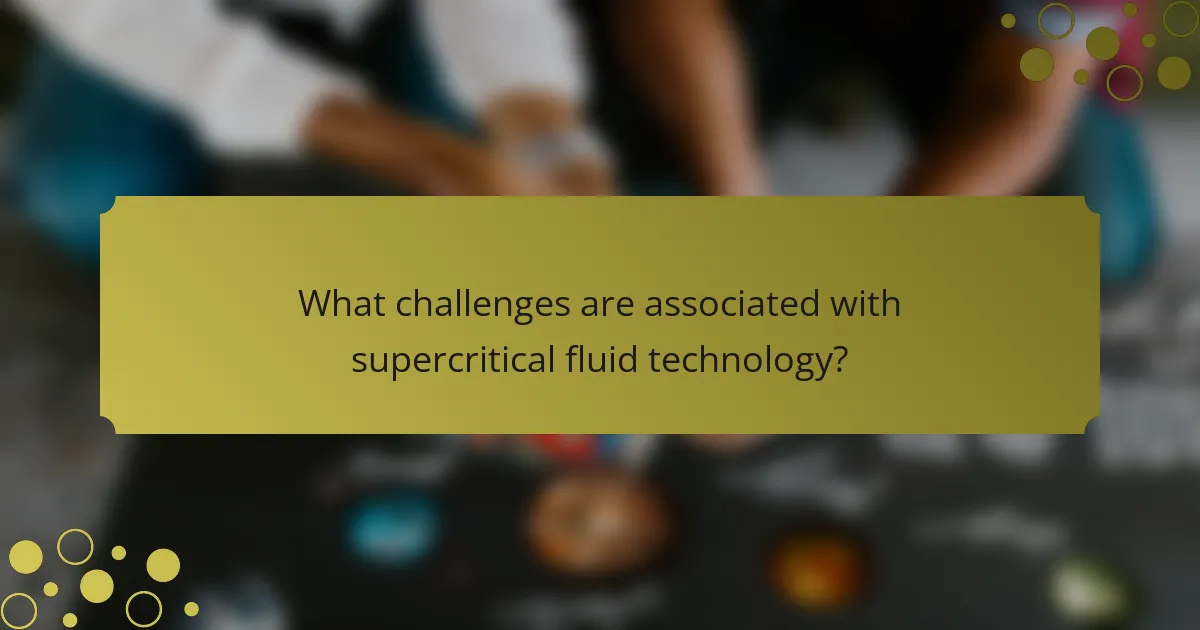
What challenges are associated with supercritical fluid technology?
Supercritical fluid technology faces several challenges. High operational pressures and temperatures are required, making equipment design complex and costly. The materials used must withstand these extreme conditions, increasing maintenance needs. Additionally, the technology requires precise control of process parameters, complicating operational efficiency. Solvent selection is critical, as not all compounds are suitable for supercritical extraction. The scalability of processes can be limited, impacting industrial application. Lastly, there is a need for further research to optimize processes and improve economic viability.
What are the limitations of supercritical fluid technology?
Supercritical fluid technology has several limitations. High operational costs are a significant barrier. The technology requires expensive equipment and maintenance. Limited solubility for certain compounds restricts its applications. Additionally, the need for precise temperature and pressure control complicates processes. Safety concerns arise due to high-pressure conditions. Scale-up for industrial use can be challenging. Regulatory hurdles may delay implementation. These factors collectively hinder widespread adoption in various industries.
How do operational costs impact the adoption of this technology?
Operational costs significantly impact the adoption of supercritical fluid technology. High operational costs can deter companies from implementing this technology. For instance, the expenses related to energy consumption, maintenance, and staffing can be substantial. Companies often weigh these costs against potential savings from reduced emissions and regulatory compliance. If the operational costs are perceived as too high, companies may delay or forgo adoption. An analysis by the Environmental Protection Agency shows that operational costs can account for up to 70% of total expenses in industrial processes. Hence, optimizing these costs is crucial for encouraging widespread adoption of supercritical fluid technology.
What technical challenges must be overcome for widespread use?
Supercritical fluid technology faces several technical challenges for widespread use. First, the high pressure and temperature required for supercritical fluids can lead to equipment stress and failure. This necessitates the development of more robust materials capable of withstanding these extreme conditions. Second, the process of extracting and recycling supercritical fluids is complex and can result in significant energy consumption. Efficient methods need to be developed to minimize energy use in these processes. Third, the scalability of supercritical fluid technology for various industrial applications remains a concern. Current systems may not be easily adaptable for different scales of operation. Fourth, the cost of supercritical fluid systems can be prohibitive, limiting adoption among smaller enterprises. Finally, regulatory hurdles and the need for standardized protocols can impede the implementation of this technology across industries. Addressing these challenges is crucial for realizing the full potential of supercritical fluid technology in reducing industrial emissions.
How can industries effectively implement supercritical fluid technology?
Industries can effectively implement supercritical fluid technology by integrating it into their existing processes. This technology utilizes supercritical fluids for extraction, separation, and reaction processes. Industries should begin by assessing their current operational needs and identifying areas where supercritical fluids can enhance efficiency. Training personnel on supercritical fluid properties and handling is essential for safe implementation.
Additionally, investing in specialized equipment designed for supercritical fluid processes is crucial. This equipment must withstand high pressures and temperatures. Pilot testing on a smaller scale can help industries evaluate the technology’s effectiveness before full-scale implementation.
Research has shown that supercritical CO2 can replace organic solvents in extraction processes, reducing environmental impact. For example, a study by S. A. M. A. Alhassan et al. in “Industrial & Engineering Chemistry Research” demonstrated that supercritical fluid extraction significantly lowers emissions compared to traditional methods. Therefore, by following these steps, industries can successfully adopt supercritical fluid technology to minimize emissions.
What best practices should industries follow when adopting this technology?
Industries adopting supercritical fluid technology should prioritize thorough training for staff. This ensures they understand the technology’s operational nuances. Implementing strict safety protocols is essential to mitigate risks associated with high-pressure systems. Regular maintenance of equipment is necessary to maintain efficiency and prevent failures. Conducting environmental impact assessments can help gauge the technology’s effectiveness in emissions reduction. Collaborating with experts in the field can provide valuable insights into best practices and innovations. Finally, continuous monitoring and data analysis are crucial for optimizing performance and achieving sustainability goals.
How can companies measure the success of emission reduction efforts?
Companies can measure the success of emission reduction efforts through specific metrics. These metrics include tracking greenhouse gas emissions before and after implementing reduction strategies. Companies can utilize carbon footprint assessments to quantify their emissions. They may also employ energy consumption data to evaluate efficiency improvements. Monitoring compliance with regulatory standards is another critical measure. Utilizing third-party audits can provide an objective analysis of emission reductions. Companies can benchmark their performance against industry standards to gauge success. Reporting progress in sustainability reports enhances transparency and accountability. Regular reviews of emission reduction goals help ensure continuous improvement.
What future developments can we expect in supercritical fluid technology?
Future developments in supercritical fluid technology will focus on enhancing efficiency and reducing costs. Innovations are expected in extraction processes, particularly for bioactive compounds. Improved separation techniques will likely emerge, increasing yield and purity. Advances in reactor design will facilitate better scalability for industrial applications. Research will also explore new solvent systems to broaden applicability. Integration with renewable energy sources may enhance sustainability. Additionally, regulatory compliance will drive the adoption of supercritical fluid technology in various industries. These trends reflect ongoing efforts to minimize industrial emissions while optimizing performance.
How might advancements in technology enhance emission reduction capabilities?
Advancements in technology can enhance emission reduction capabilities through improved efficiency and innovative processes. For instance, supercritical fluid technology allows for more effective extraction and separation processes. This technology operates at high pressure and temperature, enabling solvents to dissolve substances more effectively. As a result, it reduces the need for harmful chemicals and minimizes waste generation. Research indicates that using supercritical fluids can lead to up to a 90% reduction in volatile organic compounds (VOCs) during industrial processes. Additionally, advancements in monitoring and control systems improve real-time data collection. This enables industries to optimize operations and reduce emissions further. Overall, technology plays a crucial role in enhancing the efficiency and effectiveness of emission reduction strategies.
What trends are shaping the future of supercritical fluid applications?
Emerging trends shaping the future of supercritical fluid applications include increased environmental regulations and demand for sustainable processes. Industries are adopting supercritical fluids for their low environmental impact. These fluids reduce hazardous waste and emissions compared to traditional solvents. Innovations in extraction techniques are enhancing efficiency and selectivity. Research is focusing on expanding applications in pharmaceuticals and food industries. The integration of supercritical fluid technology with renewable energy sources is gaining traction. Additionally, advancements in equipment design are making supercritical processes more accessible. These trends reflect a shift towards greener industrial practices.
Supercritical fluid technology is a process that utilizes fluids above their critical temperature and pressure, enabling unique properties that enhance solubility and diffusivity. This technology is primarily applied in extraction processes, such as decaffeination and essential oil extraction, while also contributing to reduced industrial emissions and hazardous waste generation. The article discusses the mechanisms of supercritical fluid technology, its applications in various industries, and its role in minimizing environmental impacts through cleaner production methods. It also addresses the challenges and limitations associated with its implementation, as well as the future developments and trends shaping its use in sustainable industrial practices.
